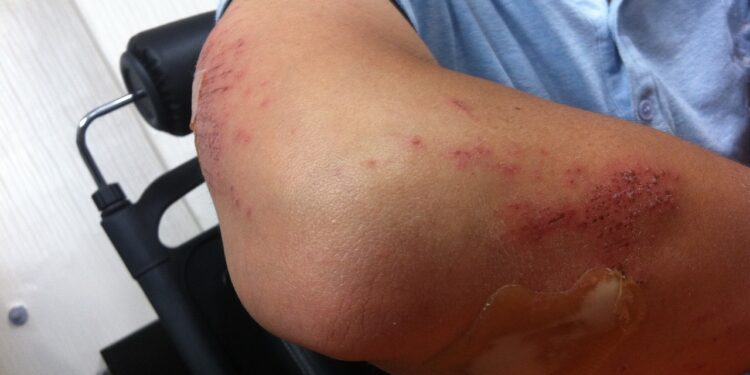Skin is the largest organ that covers and protects the entire body surface by acting as a barrier to foreign substances such as pathogens, chemicals, and UV radiation. It is a connective tissue comprising three layers; epidermis, dermis, and hypodermis.
Skin wounds usually occur because of damage to the integrity of epidermal cells. Repair, sometimes called healing, refers to restoring tissue architecture and function after an injury. By convention, the term repair is often used for parenchymal and connective tissues, and the term healing for surface epithelia. Still, these distinctions are not based on biology; we use the terms interchangeably.
Sometimes, different intrinsic and extrinsic factors can interfere with the process, causing inadequate healing with complications. Let’s break this article to discuss wound healing and the factors that affect the process:
Factors affecting wound healing
After an injury, healing is a normal biological process that occurs through different cellular, chemical, hormonal, and humoral mechanisms. Healing has three integrated stages:
1)- Inflammation
This is triggered by chemicals called inflammatory mediators, such as cytokines and oxygen-free radicals. During inflammation, a person may experience heat, pain, swelling, and redness at the injury site.
2)- Cell proliferation
In this phase, healthy cells are moved either from stem cells or remnants at the wound. Cell proliferation is promoted by signals provided by growth factors (both intrinsic and extrinsic) from the ECM or extracellular matrix.
3)- Remodeling
At the end of healing, tissue remodeling and modification occur by a family of Matrix Metallo-Proteinases (MMPs). These are dependent on iron for their activity. MMPs degrade a variety of cellular matrix constituents, such as collagen.
The above stages overlap, and a person may experience a slower healing process because of certain medical conditions such as diabetes, infections, and malnutrition.
Slow Wound Healing Causes
But some common causes of delays in healing also include the following:
1)- Oxygenation
Oxygen is necessary for energy production in the form of ATP through aerobic respiration. ATP is an energy currency used in our bodies and is a crucial requirement for successful wound healing. Inadequate oxygen supply, known as hypoxia, may lead to infections at the injury site due to low levels of super-oxides (used for killing pathogens). Temporary or short-term hypoxia triggers wound healing, but prolonged hypoxia can delay healing. In a nutshell, a proper oxygen concentration in the body is necessary for optimum and faster healing.
2)- Infections
After an injury, the body is exposed to sequestered pathogens, thus obtaining easy access to underlying tissues. Factors such as the severity of infection, type, number, and replication speed of pathogens determine the healing timeframe. Inflammation is necessary to remove infectious agents, and a person may notice prolonged inflammation if proper decontamination is incomplete. S. aureus and P. aeruginosa can cause bacterial infections and thus delay healing.
3)- Age
Age is not just a number; it affects the body’s overall performance. According to WHO, people over 60 are increasing in number, and increased age is a major factor for delayed healing. With age, skin becomes thinner, and collagen production is decreased. In aged people, T-cell infiltration, altered chemokine production, reduced phagocytic capacity and delayed re-epithelization may temporarily delay healing, but the quality of the process is not affected. Several treatments can improve the age-related delay in healing. Exercise can improve cutaneous healing by decreasing pro-inflammatory cytokine production and promoting anti-inflammatory response.
4)- Obesity
An excess and uneven fat distribution in your body can affect the healing process after an injury. A high amount of fats in the body decreases blood circulation, contributing to poor nutrition at the injury site. Lesser the nutrients, the greater will be the healing timeframe.
5)- Sex hormones
Sex hormones play an essential role in healing. Aged males show slower healing of acute wounds as compared to aged females. Androgen in males and estrogen in females influences healing. Studies show that estrogen can improve age-related healing impairment by regulating gene expression in males and females, while androgen negatively regulates healing. Abrupt hormonal change, such as due to menopause in females, can affect healing.
6)- Systemic diseases
Certain medical conditions, such as diabetes, autoimmune diseases, and sensory and autonomic neuropathies, can limit healing.
- After an injury, people should keep their blood glucose levels close to the ideal range to improve healing.
- Edema occurs because of the leakage of fluid from blood capillaries, which blocks oxygen and nutrient supply to the tissues. This can cause infections due to anaerobic pathogens, and tissue repair may stop.
- Chronic pulmonary diseases can slow the healing process by poor oxygen supply.
- During immunocompromised conditions, necessary inflammatory response stops that reduce fibroblast production leading to slower healing.
- Neurotransmitters and neuropeptides are produced by nerves responsible for dilating blood vessels and neurogenic inflammatory response. Neuropathies can limit the production of neurotransmitters and neuropeptides.
7)- Nutrition
During healing, the nutritional demand of the body is increased by 20-30%. Inadequate nutrients during these circumstances may prolong the healing process. So, it is recommended to maintain a higher level of nutrients than a normal level (RDA: Recommended Daily Allowance), depending on the size and condition of the wound. Dietitians or physicians can make personalized dietary adjustments for patients for at least 12 weeks or until the healing is completed.
Conclusion
A lack of proper care after an injury may delay healing and cause complications. You can enhance the healing process by using the correct medications and applying creams and dressings as the physician recommends. If you are unsure how to care for the wound properly, discuss it with your doctor.




